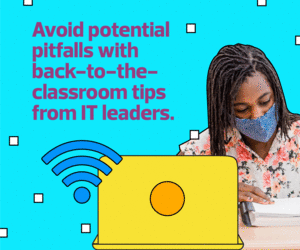Supporting Schools in Rural Areas
Students who want virtual options, for any reason, should have the opportunity to learn online. And while many districts are choosing to provide this technology to their communities, digital inequities make this a challenge for others. Rural areas with small to medium-sized districts are often overlooked and underserved.
Here, digital inequities persist. A lack of funding and a shortage of personnel make it harder to close gaps or provide the options that larger districts can offer. Creating a virtual-only model for students requires funding to start and maintain. Districts need the infrastructure, bandwidth and devices to start, on top of the licensing for various applications, and additional educator salaries to keep it running. Many educators are feeling burned out after the past year and a half and are not available to teach virtual students. Others don’t have the necessary training to do so. In most cases, virtual schools also need authorization from state departments of education, which presents an additional barrier.
INSIDER EXCLUSIVE: Navigate government funding to optimize network health for K–12.
Supporting Teachers in Learning Educational Technology
Educators who have been adapting on the fly, learning as they go and continuing to teach during the pandemic deserve the same recognition given healthcare workers. They are heroes, doing whatever it takes to keep schools running and students learning.
To this end, districts must provide technological professional development to support educators. If teachers don’t have the necessary training, they cannot provide meaningful learning environments for students in remote and hybrid learning settings.
In a pinch, they have been able to provide adequate instruction online. However, to close the equity gap for learners who will continue taking classes online while their peers return to school buildings, teachers must be trained in the technology they are using on a daily basis.
Simply using the technology isn’t enough. It must be integrated into the lessons and functioning in a way that is helpful to remote learners.
WATCH NOW: An ed tech specialist shares tips for creating online professional development.
Benefits of Remote Learning for Students
Teachers aren’t alone in developing technology skills over the past year and a half. Students, too, have found opportunities to grow and advance with the tech they’re using daily.
Participating in school remotely has taught students measurable skills, undoubtedly, but it has also helped them develop as individuals as well. They’ve learned self-discipline, time management and collaboration. The online landscape has helped them acquire research skills and taught them new ways to work alongside their peers.
Digital inequities rob students of these opportunities. As communities move back into the classroom, it’s important to remember the students who will continue to learn online and to provide meaningful opportunities for them to do so.
This article is part of the “ConnectIT: Bridging the Gap Between Education and Technology” series. Please join the discussion on Twitter by using the #ConnectIT hashtag.
![[title]Connect IT: Bridging the Gap Between Education and Technology](http://www.edtechmagazine.com/k12/sites/default/files/articles/2014/05/connectit.jpg)











